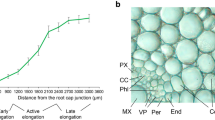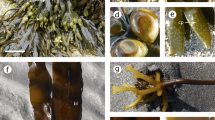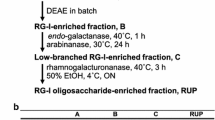Summary
Two polyclonal antisera, anti-xyloglucan (anti-XG) and anti-polygalacturonic acid/rhamnogalacturonan I (anti-PGA/RG-I), which recognize, respectively, noncellulosic β-(1→4)-D-glucan containing polysaccharides and the unesterified forms of the acidic pectic polysaccharide polygalacturonic acid/rhamnogalacturonan I, were used to localize epitopes recognized by the two antisera in the root tip of oat (Avena sativa). Immunoblot analysis shows that epitopes recognized by the anti-XG antibodies are present in both the mixed linkage β-(1→3)-(1→4)-D-glucans (MG) and in xyloglucan (XG). Immunogold electron microscopy shows that the cell walls of meristematic, cortical, epidermal, columella, and peripheral cells contain significant amounts of such epitopes. In contrast, the molecules that carry these MG/XG epitopes appear to be sparse in the expanded middle lamella of meristematic cells, but dense in the expanded middle lamella of peripheral root cap cells. This finding suggests that the porosity of the middle lamella is altered in peripheral root cap cells to facilitate mucilage secretion. In contrast, few PGA/RG-I epitopes were detected in any cell walls of any of the cell types examined. Double immunogold labeling experiments revealed an intriguing localization pattern of MG/XG and of PGA/RG-I epitopes in the peripheral mucilage-secreting cells of the root cap. Whereas MG/XG epitopes were abundant in the cell wall, they were sparse in both the secreted mucilage and in intracellular secretory vesicles. In marked contrast, PGA/RG-I epitopes were detected at high density in intracellular secretory vesicles, but unexpectedly, were quite sparse in both the cell wall and in the mucilage. These immunolabeling patterns are consistent with the hypotheses that the synthesis and secretion of particular β-D-glucans is subject to both activation and down-regulation during cell development and differentiation and that post-secretory alterations of pectic polysaccharides, such as enzymatic release of RG-I-type mucilage molecules from PGA/RG-I precursors, may occur in the peripheral cell walls of the oat root cap.
Similar content being viewed by others
Abbreviations
- MG:
-
mixed linkage β-(1→3)-(1→4)-D-glucan
- PGA/RG-I:
-
polygalacturonic acid/rhamnogalacturonan I
- SEPS:
-
sycamore extracellular polysaccharides
- TGN:
-
trans Golgi network
- XG:
-
xyloglucan
References
Bacic A, Moody SF, Clarke AE (1986) Structural analysis of secreted root slime from maize (Zea mays L). Plant Physiol 80: 771–777
Baron-Epel O, Gharyal PK, Schlinder M (1988) Pectins as mediators of wall porosity in soybean cells. Planta 175: 389–395
Becker GE, Hui PA, Albersheim P (1964) Synthesis of extracellular polysaccharides by suspensions ofAcer pseudoplatanus cells. Plant Physiol 39: 913–920
Carpita NC (1984) Cell wall development in maize coleoptiles. Plant Physiol 76: 205–212
—, Gibeaut DM (1993) Structural models of primary cell walls in flowering plants: consistency of molecular structure with the physical properties of the walls during growth. Plant J 3: 1–30
Chaboud A, Rougier M (1984) Identification and localization of sugar components of rice (Oryza sativum L.) root cap mucilage. J Plant Physiol 116: 323–330
Conrad PA, Binari LLW, Racusen RH (1983) Rapidly-secreting, cultured oat cells serve as a model system for the study of cellular exocytosis. Characterization of cells and isolated secretory vesicles. Protoplasma 112: 196–204
Dazzo FB, Hollingsworth RI, Philip-Hollingsworth S, Smith KB, Welsch MA, Djordjevic M, Rolfe BG (1988) Early recognition signals in theRhizobium trifolii white clover symbiosis. In: Scanerini S, Smith D, Bonfante-Fasolo P, Gianiniazzi-Pearson V (eds) Cell to cell signals in plant, animal and microbial symbiosis. Springer, Berlin Heidelberg New York Tokyo, pp 183–187
Estrada-Garcia T, Ray TC, Green JR, Callow JA, Kennedy JF (1990) Encystment ofPythium aphanidermatum zoospores is induced by root mucilage polysaccharides, pectin and a monoclonal antibody to a surface antigen. J Exp Bot 41: 693–699
Fry SC (1988) The growing plant cell wall: chemical and metabolic analysis. Wiley, New York
Griffing LR (1991) Comparisons of Golgi structure and dynamics in plant and animal cells. J Electron Microsc Techn 17: 179–199
Hoson T, Nevins DJ (1989) β-D-glucan antibodies inhibit auxininduced cell elongation and changes in the cell wall ofZea coleoptile segments. Plant Physiol 90: 1353–1358
Jarvis MC, Forsyth W, Duncan HJ (1988) A survey of pectic content of nonlignified monocot cell walls. Plant Physiol 88: 309–314
Kato Y, Nevins DJ (1984 a) Enzymic dissociation ofZea shoot cell wall polysaccharides I. Preliminary characterization of the water-insoluble fraction ofZea shoot cell walls. Plant Physiol 75: 740–744
— — (1984 b) Enzymic dissociation ofZea shoot cell wall polysaccharides II. Dissociation of (1→3),(1→4)-β-D-glucan 4-glucanohydrolase fromBacillus subtilis. Plant Physiol 75: 745–752
Knox JP, Linstead PJ, King J, Cooper C, Roberts K (1990) Pectin esterification is spatially regulated both within cell walls and between developing tissues of root apices. Planta 181: 512–521
— —, Peart J, Cooper C, Roberts K (1991) Developmentally regulated epitopes of cell surface arabinogalactan proteins and their relation to root tissue pattern formation. Plant J 1: 317–326
Labavitch JM, Ray PM (1978) Structure of hemicellulosic polysaccharides ofAvena saliva coleoptile cell walls. Phytochemistry 17: 933–937
Liners F, Van Cutsem P (1991) Immunocytochemical localization of homopolygalacturonic acid on plant cell walls. Micron Microsc Acta 22: 265–266
— — (1992) Distribution of pectic polysaccharides throughout walls of suspension-cultured carrot cells. Protoplasma 170: 10–21
Luttenegger DG, Nevins DJ (1985) Transient nature of a (1→3), (1→4)-β-D-glucan inZea mays coleoptile cell walls. Plant Physiol 77: 175–178
Lynch MA, Staehelin LA (1992) Domain-specific and cell-type specific localization of two types of cell wall matrix polysaccharides in the clover root tip. J Cell Biol 118: 467–480
McCann MC, Roberts K (1991) Architecture of the primary cell wall. In: Lloyd CW (ed) The cytoskeletal basis of plant growth and form. Academic Press, San Diego, pp 109–128
Moody SF, Clarke AE, Bacic A (1988) Structural analysis of secreted slime from wheat and cowpea roots. Phytochemistry 27: 2857–2861
Moore PJ, Darvill AG, Albersheim P, Staehelin LA (1986) Immunogold localization of xyloglucan and rhamnogalacturonan I in the cell walls of suspension-cultured sycamore cells. Plant Physiol 82: 787–794
—, Swords KMM, Lynch MA, Staehelin LA (1991) Spatial organization of the assembly pathways of glycoproteins and complex polysaccharides in the Golgi apparatus of plants. J Cell Biol 112: 589–602
Peretto R, Faccio A, Bonfante-Fasolo P (1990) Cell surface localization inCalluna vulgaris L. hair roots: in situ localization of polysaccharidic components. Protoplasma 155: 1–18
Racusen RH (1988) Separation of dense, polysaccharide-containing vesicles from secreting, cultured oat cells. Characterization of a putative secretory vesicle fraction. Physiol Plant 74: 752–762
Ray TC, Callow JA, Kennedy FJ (1988) Composition of root mucilage polysaccharides fromLepidium sativum. J Exp Bot 39: 1249–1261
Roy S, Vian B, Roland J (1992) Immunocytochemical study of the deesterification patterns during cell wall autolysis in the ripening to cherry tomato. Plant Physiol Biochem 30: 139–146
Sherrier DJ, VandenBosch KA (1994) Secretion of cell wall polysaccharides inVivia root hairs. Plant J 5: 185–195
Stevenson TT, McNeil M, Darvill AG, Albersheim P (1986) Structure of plant cell walls. XVIII. An analysis of the extracellular polysaccharides of suspension-cultured sycamore cells. Plant Physiol 80: 1012–1019
Stout RG, Griffing LR (1993) Transmural secretion of a highly-expressed cell surface antigen of oat root cap cells. Protoplasma 172: 27–37
Author information
Authors and Affiliations
Rights and permissions
About this article
Cite this article
Lynch, M.A., Staehelin, L.A. Immunocytochemical localization of cell wall polysaccharides in the root tip ofAvena sativa . Protoplasma 188, 115–127 (1995). https://doi.org/10.1007/BF01276802
Received:
Accepted:
Issue Date:
DOI: https://doi.org/10.1007/BF01276802




